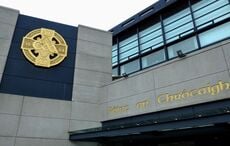Dublin diver Rory Golden was the first Irishman and one of the few people anywhere to dive to the shipwreck of the Titanic. He will share his experiences at the Let’s Talk Titanic lecture series at the former Harland and Wolff Drawing Office organized by Titanic Belfast.
Golden’s first dive to the ship was in 2000. Originally Golden was not asked to dive, but he was asked to partake in an expedition organized by the owners RMS Titanic to recover artifacts. Golden brought a plaque celebrating the ship’s link with Cobh in Cork, which was her final port of call and was asked to place the plaque on the Titanic.
The descent two and a half miles down took two and a half hours in a submersible. The submersible landed some distance from the wreck and slowly approached the ship. He recalls in the Belfast Telegraph, “Peering out through the darkness, you just see this shape and shadow.”
He continued, “The first time you rise up along the side and you see these massive rows of rivets. It’s quite a spine-tingling experience- that you are there where so few people have been.
“You’re going through feelings of excitement, you’re going through feelings of sadness, you’re going through feelings of wonder and you don’t think about the fact that, outside, the water pressure is crushing.”
He made his second trip in 2005 as part of a documentary and brought two plaques from Belfast to lay on the wreck. One was a replica of the plaque outside Belfast City Hall that remembers those lost in the sinking. The second was from shipyard Harland and Wolff who built the Titanic. He said, “The plaques were put on all that is left of the bridge of the ship, which once held the wheel and the ship’s telegraph.”
During the sinking, the Titanic broke in two. The bow sank more slowly and the fallen mast of the ship can still be seen. The other portion sank quicker and fell apart on the ocean floor. Golden described it, “It’s just one big mess of tangled mess of steel and debris. You can see the engines in that part and you can make out the stern, but you have to take a really hard look.” The apartments which once housed people from various walks of life heading to America now house prawns, crabs and small plants.
Despite the deteriorated state of the ship, Golden has found wonder in the wreck. He said, “It’s amazing to think how deep and dark it is and yet life is continuing on.”
Golden will talk about his experiences on October 17, 2013 and the next day he will talk about his friend and cameraman Ralphie White, who took the first photographs of the wreck during the 1985 expedition when Titanic’s resting place was finally discovered. White has made 35 dives to the ship in 20 years.
For more information visit www.titanicbelfast.com website.
Started in 1909, Harland and Wolff took three years to build the Titanic in Belfast. She left Southampton, England on April 10, 1912 on her maiden voyage to New York. Titanic’s last stop was in Queenstown on April 11. She hit an iceberg in the evening of April 14 and in less than three hours sank in the early morning of April 15.
For decades the resting place of Titanic was unknown. A joint exploration by the Woods Hole Deep Submergence Lab led by Dr. Robert Ballard and the Institut Francais de Recherche pour l’Exploitation des Mers (French Institute for the Exploration of the Sea) led by Jean-Louis Michel found the wreck off the coast of Newfoundland in 1985.




Comments